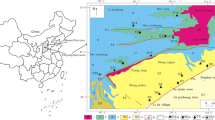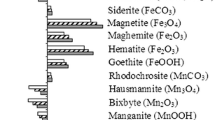Abstract
Inorganic pollutants in groundwater, such as sulfate and nitrate, have been a serious problem in China for decades. These pollutants are difficult to be removed because of their high solubility and ease of transport in subsurface environment. It had been found that microorganism could be one of the most feasible methods for inorganic pollutant elimination. During the process of degradation, some microorganisms can utilize sulfur and nitrogen in sulfate and nitrate forms, respectively, as energy sources. Meanwhile, significant variations of sulfur stable isotope ratios happened. Therefore sulfur isotope can be used as a good indicator for pollutant degradation and microbial activities. Shallow groundwater (SGW), deep groundwater (DGW), and surface water (SFW) were investigated in alluvial plain in Jiaozuo City, China. The results of hydrochemical analysis indicated that K+, Na+, and HCO3 − were dominant ions in DGW, Mg2+ and HCO3 − were dominant ions in SGW, and Ca2+ and HCO3 − were dominant in SFW except for LR sample. A wide variation of δ 34SSO4 values ranging from + 7.3 to +23.6 ‰ had been observed for all water samples, with a mean value of +20.7, +12.6 and +10.0 ‰ for DGW, SGW, and SFW respectively. At the same time, δ 13C values of dissolved inorganic carbon (DIC) ranged from −12.4 to −5.7 ‰, with a mean value of −7.5, −9.0, and −9.6 ‰ for DGW, SGW, and SFW, respectively. The microbial degradation processes resulted in significant sulfur isotope fractionations in DGW. Organic carbon was utilized by bacteria and transferred into inorganic carbon, leading to negative fractionation of carbon isotopes. Thus the variations in stable isotope ratios of sulfur and carbon in groundwater can be used as good indicators for understanding of the relationship between bacteria behaviors and sulfate degradation.












Similar content being viewed by others
References
Amiotte Suchet P, Aubert D, Probst JL, Gauthier-Lafaye F, Andreux F, Viville D (1999) δ13C pattern of dissolved inorganic carbon in a small granitic catchment: the Strengbach case study (Vosges mountains, France). Chem Geol 159:129–145
Ansari AH, Hodson AJ, Heaton THE, Kaiser J, Marca-Bell A (2013) Stable isotopic evidence for nitrification and denitrification in a High Arctic glacial ecosystem. Biogeochemistry 113:341–357
Antler G, Turchyn AV, Rennie V et al (2013) Coupled sulfur and oxygen isotope insight into bacterial sulfate reduction in the natural environment. Geochim Cosmochim Acta 118:98–117
Atekwana EA, Krishnamurthy RV (1998) Seasonal variations of dissolved inorganic carbon and δ 13C of surface water: application of a modified gas evolution technique. J Hydrol 205:265–278
Aucour AM, Sheppard SMF, Guyomar O, Wattelet J (1999) Use of 13C to trace origin and cycling of inorganic carbon in the Rhôme Wattelet. Chem Geol 159:87–105
Bottrell S, Tellam J, Bartlett R, Hughes A (2008) Isotopic composition of sulfate as a tracer of natural and anthropogenic influences on groundwater geochemistry in an urban sandstone aquifer, Birmingham, UK. Appl Geochem 23:2382–2394
Choi BY, Yun ST, Mayer B, Kim KH (2011) Sources and biogeochemical behavior of nitrate and sulfate in an alluvial aquifer: hydrochemical and stable isotope approaches. Appl Geochem 26:1249–1260
Doussan C, Poitevin G, Ledoux E, Detay M (1997) River bank filtration: modeling of the changes in water chemistry with emphasis on nitrogen species. J Contam Hydrol 25:129–156
Górka M, Sauer PE, Szczebak DL, Jedrysek MO (2011) Carbon isotope signature of dissolved inorganic carbon (DIC) in precipitation and atmospheric CO2. Environ Pollut 159:294–301
Gunn J, Bottrell SH, Lowe DJ, Worthington SRH (2006) Deep groundwater flow and geochemical processes in limestone aquifers: evidence from thermal waters in Derbyshire, England, UK. Hydrogeol J 14:868–881
Han G, Tang Y, Wu Q (2010) Hydrogeochemistry and dissolved inorganic carbon isotopic composition on karst groundwater in Maolan, southwest China. Environ Earth Sci 60:893–899
Hosono T, Siringan F, Yamanaka T, Umezawa Y, Onodera S, Nakano T, Taniguchi M (2010) Application of multi-isotope ratios to study the source and quality of urban groundwater in Metro Manila, Philippines. Appl Geochem 25:900–909
Kanduč T, Szramek K, Ogrinc N, Walter LM (2007) Origin and cycling of riverine inorganic carbon in the Sava River watershed (Slovenia) inferred from major solutes and stable carbon isotopes. Biogeochemistry 86:137–154
Knöller K, Schubert M (2010) Interaction of dissolved and sedimentary sulfur compounds in contaminated aquifers. Chem Geol 276:284–293
Lambert WJ, Aharon P (2011) Controls on dissolved inorganic carbon and δ13C in cave waters from DeSoto Caverns: implications for speleothem δ13C assessments. Geochim Cosmochim Acta 75:753–768
Lambs L, Brunet F, Probst J (2009) Isotopic characteristics of the Garonne River and its tributaries. Rapid Commun Mass Spectrom 23:2543–2550
Li SL, Liu CQ, Tao FX, Lang YC, Han GL (2005) Carbon biogeochemistry of ground water, Guiyang, Southwest China. Ground Water 43:494–499
Li X, Masuda H, Kusakabe M, Yanagisawa F, Zeng H (2006) Degradation of groundwater quality due to anthropogenic sulfur and nitrogen contamination in the Sichuan Basin, China. Geochem J 40:309–332
Li XD, Liu CQ, Harue M, Li SL, Liu XL (2010) The use of environmental isotopic (C, Sr, S) and hydrochemical tracers to characterize anthropogenic effects on karst groundwater quality: a case study of the Shuicheng Basin, SW China. Appl Geochem 25:1924–1936
Li X, Zhou A, Gan Y, Yu T, Wang D, Liu Y (2011) Controls on the δ 34S and δ 18O of dissolved sulfate in the Quaternary aquifers of the North China Plain. J Hydrol 400:312–322
Mayer B, Shanley JB, Bailey SW, Mitchell MJ (2010) Identifying sources of stream water sulfate after a summer drought in the Sleepers River Watershed (Vermont, USA) using hydrological, chemical, and isotopic techniques. Appl Geochem 25:747–754
Moncaster SJ, Bottrell SH, Tellam JH, Lloyd JW, Konhauser KO (2000) Migration and attenuation of agrochemical pollutants: insights from isotope analysis of groundwater sulphate. J Contam Hydrol 43:147–163
Nisi B, Bccianti A, Vaselli O, Perini G, Tassi F, Minissale A, Montegrossi G (2008) Hydrogeochemistry and strontium isotopes in the Arno River Basin (Tuscany, Italy): constraints on natural controls by statistical modeling. J Hydrol 360:166–183
Otero N, Vitòria L, Soler A, Canals A (2005) Fertiliser characterization: major, trace and rare earth elements. Appl Geochem 20:1473–1488
Otero N, Torrentó C, Soler A, Menció A, Mas-Pla J (2009) Monitoring groundwater nitrate attenuation in a regional system coupling hydrogeology with multi-isotopic methods: the case of Plana de Vic (Osona, Spain). Agric, Ecosyst Environ 133:103–113
Ouyang Y, Zhang JE, Parajuli P (2013) Characterization of shallow groundwater quality in the Lower St Johns River Basin: a case study. Environ Sci Pollut Res. doi:10.1007/s11356-013-1864-x
Rees CE (1973) A steady-state model for sulphur isotope fractionation in bacterial reduction processes. Geochim Cosmochim Acta 37:1141–1162
Sarkar A, Kazy SK, Sar P (2013) Characterization of arsenic resistant bacteria from arsenic rich groundwater of West Bengal, India. Ecotoxicology 22:363–376
Somay MA, Gemici U (2012) Groundwater quality degradation in the Buyuk Menderes River coastal wetland. Water Air Soil Pollut 223:15–27
Trettin R, Knöller K, Loosli HH, Kowski P (2002) Evaluation of the sulfate dynamics in groundwater by means of environmental isotopes. Isot Environ Healt S 38:103–119
Vitòria L, Otero N, Soler A, Canals À (2004) Fertilizer characterization: isotopic data (N, S, O, C and Sr). Environ Sci Technol 38:3254–3262
Xie X, Wang Y, Ellis A, Li J, Su C, Duan M (2013) Multiple isotope (O, S and C) approach elucidates the enrichment of arsenic in the groundwater from the Datong Basin, Northern China. J Hydrol 498:103–112
Yamanaka M, Nakano T, Tase N (2007) Sulfate reduction and sulfide oxidation in anoxic confined aquifers in the northeastern Osaka Basin, Japan. J Hydrol 335:55–67
Yang C, Telmer K, Veizer J (1996) Chemical dynamics of the “St. Lawrance” riverine system: δDH2O, δ13CDIC, δ34Ssulfate and dissolved 87Sr/86Sr. Geochim Cosmochim Acta 60:851–866
Yang YC, Shen ZL, Wen DG, Hou GC, Zhao ZH, Wang D (2008) Hydrochemical Characteristics and Sources of Sulfate in Groundwater of the Ordos Cretaceous Groundwater Basin. Acta Geoscientia Sinica 29:248–254 (in chinese)
Zhang Y, Liu XJ, Fangmeier A, Goulding KTW, Zhang FS (2008) Nitrogen inputs and isotopes in precipitation in the North China Plain. Atmos Environ 42:1436–1448
Zhang JX, Liang YP, Wang WT, Han XR, Hou GC (2009) A practical use of 34S in the investigation of karst groundwater resource in North China. Carsologica Sinica 28:235–241 (in chinese)
Zhao BZ, Zhang JB, Flury M, Zhu AN, Jiang QA, Bi JW (2007) Groundwater contamination with NO3-N in a wheat-corn cropping system in the North China Plain. Pedosphere 17:721–731
Acknowledgments
This work was supported by National Natural Science Foundation of China (No. 41103053). We also thank Yongqiang Yuan for his field help and Ning An for his measurement of sulfur isotope and carbon isotope. Constructive comments and critical modifications provided by several anonymous reviewers.
Conflict of interest
The authors declare that they have no conflict of interest.
Author information
Authors and Affiliations
Corresponding author
Rights and permissions
About this article
Cite this article
Zhang, D., Liu, C. A preliminary study on sulfate reduction bacteria behaviors in groundwater by sulfur and carbon isotopes: a case study in Jiaozuo City, China. Ecotoxicology 23, 2014–2024 (2014). https://doi.org/10.1007/s10646-014-1330-7
Accepted:
Published:
Issue Date:
DOI: https://doi.org/10.1007/s10646-014-1330-7




